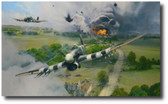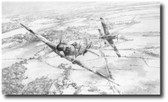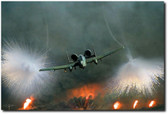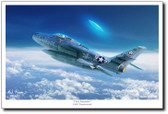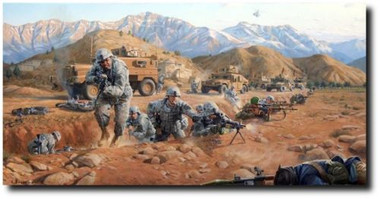 Loading... Please wait...
Loading... Please wait...- Home
- Aviation Art - By Artist
- Larry Selman
- Closing the Distance
Categories
Closing the Distance
Product Description
About Planejunkie:
Planejunkie is a division of a 25 year old company. We've specialized in Aviation, Historical and Military Art and have worked directly with the Artists and Pilots you'll see on our products. Since we are fairly new to E-bay don't be alarmed that we don't have an extensive history rating. Be assured that your Prints and Aviation Collectibles will be authentic and will ship on time. We pride ourselves in quality products and customer satisfaction. Check out our entire line... Thanks!
L/E of 100 (Publishers Proofs)...$135.00
Image Size: 29" x 14.5"
ALSO AVAILABLE AS...
L/E of 100 (Artist Proofs)...$165.00
Image Size: 29" x 14.5"
"The Fighting 48th Infantry Brigade Combat Team in Afghanistan" The 48th Infantry Brigade Combat Team (IBCT) of the Georgia Army National Guard deployed to the Islamic Republic of Afghanistan in the spring of 2009 in support of Operation Enduring Freedom. Organized as Task Force Volunteer, the mission of the 48th IBCT was to train, mentor, & partner with the Afghan National Security Forces (ANSF) thru "combined action" conducting combat operations against the insurgent Taliban forces. The ANSF consisted of the Afghan National Army, Afghan Uniformed Police, & Afghan Border Police with the focus of operations "by, with, & thru" the Afghan forces.
The end-state was to develop the ANSF into a well-trained, self-sufficient, & relevant combined-arms combat force capable of decisively defeating its current & future enemies, while maintaining national security for its citizens. The 48th IBCT was lead by the Brigade Commander Colonel Lee K. Durham and the Brigade Command Sergeant Major Michael B. Hurndon. The Soldiers of the Brigade underwent 18-months of extensive and tough counterinsurgency & light infantry combat training in preparation for the year-long deployment prior to arriving in Afghanistan. The command intent was a stated focus on decentralized operations, junior leader development & empowerment, and well-rehearsed & disciplined close-combat operations. The Command knew the absolute key to success in the asymmetrical warfare challenge would be the junior officer, the squad & team leader, & the "strategic corporal" on the ground, in the fight daily against the enemy forces.
The 48th IBCT, with its six organic battalions were assigned to Combined Joint Task Force 82nd Airborne & given responsibility of combat operations in areas of Regional Command East, North, & the Kabul Province as members of the International Security Assistance Forces (ISAF). The 1-108th Cavalry Squadron (RSTA) was the first battalion of the 48th IBCT to arrive on ground with its lead elements stepping onto Afghan soil in April of 2009 as Task Force Rough Rider. The command team of LTC Randall V. Simmons, Jr. & CSM Joseph E. Recker, Jr. initially led the "Rough Riders" into Kapisa, Parwan, Bamian, Panjshir, Lowgar, Wardak, Laghman, Nangarhar, Kunar, and Nuristan Provinces to conduct operations as Embedded Training Teams. Some of the fiercest fighting of the deployment was encountered in the Al Assay Valley, Kapisa Province with the unit’s first losses occurring in this austere mountain region. The 1-108th later consolidated in the Nangarhar Province conducting full-spectrum operations, achieving renowned strategic success with the development and signing of the anti-Taliban pact by the regionally significant Shinwari Tribal elders.
The 1st Battalion, 121st Infantry Regiment "Spartans", led by LTC Matthew D. Smith & CSM Robert E. Hawk, deployed as Task Force Dahlonega in the provinces of Paktya, Paktika, Khwost, & Ghazni. The unit was also assigned as the battle-space owners for the entire Paktya Province successfully conducting "combined action" with all elements of the ANSF. The 1-121st IN gained a notable reputation for effectively conducting the counterinsurgency in accordance with the ISAF Commander’s battle plan eliminating a half-dozen high value targets within the first two months of assuming the mission. This was a hard-fought success in one of the most highly contested areas of the country along the Pakistan border deep within the Hindu Kush mountain range. The 2nd Battalion, 121st Infantry Regiment "Warriors", led by LTC Louie K. Payne & CSM Phillip A. Stringfield, deployed to Regional Command North and conducted operations throughout the region including Mazar E Sharif, Konduz, Meymaneh, Shebergean, & Feyzabad. Task Force Warrior worked in conjunction with the German coalition partners successfully defeating the insurgent forces, while also significantly enhancing ANSF capabilities thru direct mentorship within the region.
Often overlooked as a contentious area, the valiant Warriors of the 2-121st braved countless direct engagements and decisively took it to the enemy, shoulder-to-shoulder with their Afghan partners. The 1-118th Field Artillery Regiment, commanded by LTC Reginald G.A. Neal & CSM M. Wesley Dover, honed their resilient artilleryman into effective Embedded Training Teams as Task Force Kabul. This historical battalion known as "Hickory", established and greatly enhanced counterinsurgency operations and overall security for the urban and outlying areas in and around the Afghan capital of Kabul. Amid the unique urban challenges of the largest city in Afghanistan, the 1-118th FAR excelled and made a significant impact. The 148th Brigade Support Battalion, lead by the command team of LTC Perry A. Carter & CSM Barry Smallwood, deployed into the theater of operations as Task Force Wishmaster. The "Wishmasters" successfully operated throughout the entire vast geography of Afghanistan providing dispersed combat units with essential resupply materials of "water, beans & bullets", along with maintenance assets, and medical support. This support was directed at the Volunteers of the 48th IBCT, but also the entire combined joint area of operations. The 48th Brigade Special Troops Battalion was commanded by LTC Thomas J. Bright & CSM Jackie E. Faulkner, and was known as the "Stryker Battalion." They had full responsibility for the force protection, outer security, and total operations of Camp Phoenix, the "1,000-person camp" just east of Kabul which served as the headquarters of the 48th IBCT and Task Force Volunteer. The 48th BSTB was instrumental and directly responsible for defeating multiple coordinated enemy assaults on Camp Phoenix, and the "Strykers" were inspiringly courageous by dispatching their ill-willed adversaries by "closing the distance!"
The 48th IBCT traces its lineage to the Macon Volunteers of 1825 & is proudly known as the "Volunteer Brigade." The unit and its valiant Soldiers have participated in every major conflict since that period including the Seminole War, Civil War, Mexican War, Spanish-American War, WWI, WWII, Desert Shield, Operation Iraqi Freedom, and now Operation Enduring Freedom. The Volunteer Warriors from Georgia stand-ready to the answer the next call to arms in defense of the United States of American, whenever "it shall be done!" The print Closing the Distance by Larry Selman is officially dedicated to the "Fallen Eight of the Fighting 48th" who made the ultimate sacrifice on the battlefields of Afghanistan in 2009, the 49 "Volunteers" that were also wounded in action, and all their sacrificing families.
These brothers-in-arms that lived, fought, & gave all for a cause much greater than themselves will never be forgotten: MAJ Kevin M. Jenrette, SFC John C. Beale, & SGT Jeffery W. Jordan of 1-108th CAV(RSTA) killed in action 04JUN2009, 1SG John D. Blair of 1-121st IN BN killed in action 20JUN2009, SGT Brock H. Chavers & SGT Isaac L. Johnson, Jr. of 2-121st IN BN killed in action 06JUL2009, SGT Raymundo P. Morales of 1-108th CAV(RSTA) killed 21JUL2009, and SSG Alex French, IV killed in action 30SEP2009. It was asked long ago, "Who Shall We Send & Who Will Go for Us?" And they said, "Here I Am; SEND ME!"

